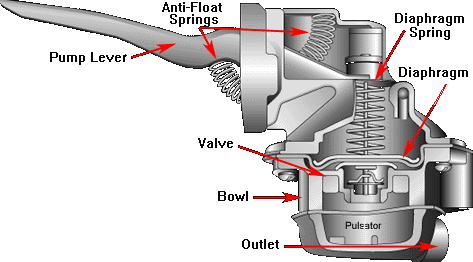Fuel pumps come in a variety of designs.
In the most general terms, you can choose between mechanical, belt-drive, and electric (inline and in-tank) pumps. We wrote an earlier post discussing the differences between mechanical and electric fuel pumps and another on how to choose the right size fuel pump in terms of volume and pressure.
One topic we’ve haven’t covered, though, is internal fuel pump design.
Browsing Summit Racing, you’ll notice different brands touting things like rotary vane and gerotor designs. The goal of this post is to educate you on these designs, and explain the advantages of each.
Rotary Vane-Style Fuel Pumps
Rotary vane pumps feature a paddle-wheel device inside a larger circular housing. The wheel is offset inside the circular housing, creating a crescent-shaped cavity. Paddles on the wheel slide in and out as the wheel spins inside the cavity, drawing fuel into the pump though the inlet. The paddles push fuel around the housing and compress the fuel as it reaches the narrow point of the crescent on the outlet side (see image above). Eventually, the paddles push the fuel through the outlet under pressure.
Due to the sliding motion of the paddles, traditional sliding-style rotary vane pumps create a lot of internal friction. For high-pressure applications, a roller vane version of the rotary vane is often preferred. This design uses the same basic principle of the sliding-style pumps, but a roller bar is used in place of the paddles. The roller bar reduces friction and increases the efficiency of the pump, making it a better choice for higher-pressure applications.
Although rotary vane pumps are considered efficient, they are louder than gerotor-style pumps. Holley’s famous Red electric fuel pumps and Blue electric pumps are examples of rotary vane fuel pumps.
Gerotor-Style Fuel Pumps
Gerotor is a common design for high-pressure, high-volume electric fuel pumps and can be found on some belt-drive pumps. A gerotor pump incorporates two gears—a spur gear and ring gear. As the inner spur gear spins, it meshes with the outer ring gear, causing the ring gear inside the cavity to rotate. This creates suction on the inlet and produces pressure on the outlet, which makes gerotor pumps highly efficient and the ability to build high pressures—all while making little noise.
Gerotor pumps do have some drawbacks, however. They are susceptible to damage from contaminants and can experience cavitation (read more about cavitation here) because of the amount vacuum they produce. You can avoid cavitation issues by mounting the pump as close to the tank as possible, and using a good gravity feed to reduce vacuum.
Diaphragm-Style Fuel Pumps
Conventional mechanical fuel pumps rely on a diaphragm design.
Diaphragm pumps use a flexible membrane, usually a rubber composite, that moves in an up-down motion inside a chamber. The chamber has an input and an output, and check valves ensure fuel flows only in one direction. A lever on the pump fits onto an eccentric lobe on the camshaft (some models have a fuel pump pushrod between the lever and the cam eccentric). As the cam spins, it moves the lever and pulls the diaphragm down. This increases the size of the pump chamber and draws fuel into the pump. As the diaphragm pushes up to top dead center (aided by a diaphragm spring) the fuel is forced from the chamber and into the feed line. Fuel pressure is regulated by the force applied by the diaphragm spring.
Since the fuel doesn’t flow through the membrane, debris and other contaminants are less likely to damage a diaphragm-style pump. Another advantage is that return lines aren’t necessarily required during installation, because this type of pump operates typically at low pressures.
On the flip side, their high vacuum makes diaphragm pumps vulnerable to vapor lock or cavitation. Diaphragm pumps are also somewhat limited in their capability, so they’re usually recommended for carbureted applications where higher pressures aren’t needed.
Piston-Style Fuel Pumps
Piston-style pumps are similar to diaphragm-style mechanical pumps; however, they use a reciprocating piston instead of a diaphragm. Like a diaphragm pump, the piston pump draws fuel into the pump and forces it out under pressure. The piston action can create more pressure and flow than the old school diaphragm pump with no diaphragm to rupture.
Race Pumps was a pioneer of piston-style fuel pumps. The company manufactured piston-style pumps with a variable displacement design. This allowed the pump to deliver the precise amount of fuel required by the engine with no wild pressure fluctuations. It also eliminated the need for a bypass regulator or return line.
Piston-style pumps have fewer moving parts than other designs, can be rebuilt, and use less engine power than conventional mechanical pumps.





THANKS DAVID..I HAVE A F550 FORD BUCKET TRUCK 2008 WITH A 6.4 DIESEL ..IT SEEMS TO RUN FINE ,BUT PEOPLE ARE TELLING ME TO GET A LIFE PUMP FOR IT
RACE PUMPS WENT OUT OF BISS,
do they make an electric fuel pump that can be mounted above the full tank? I have a fuel tank with outlet hose is on top of the tank and the electric pump has to suck the fuel out, rather than gravity so the pumps keep going out.
Hey George, your issue may not be the pump design, but instead where it is mounted. As a rule of thumb, an external electric fuel pump should be mounted as low as safely possible and as close to the tank as possible. You should also keep it (and the fuel line) away from heat, so be mindful of where your exhaust is routed. You’ll probably want to install a filter before the pump as well. Finally, are you filling-up with an ethanol-blended fuel? You may want to check your pump’s compatibility with ethanol.